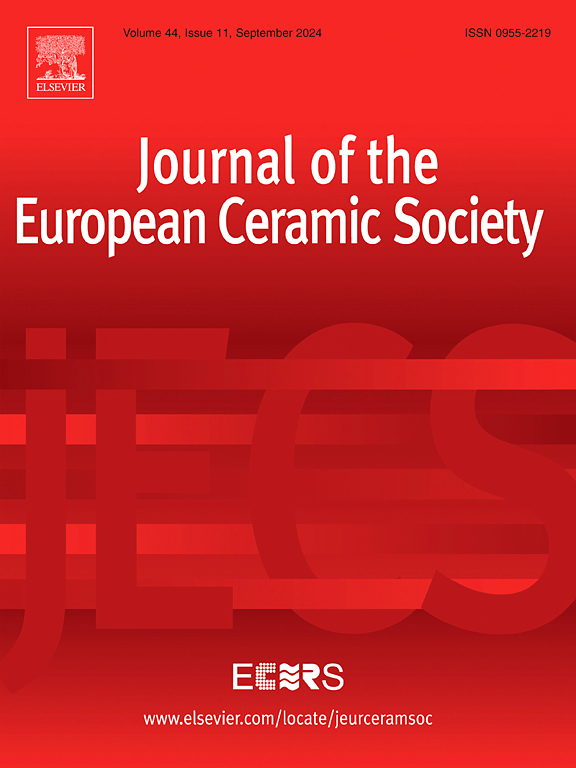氢氧化物混合物中氧化钇稳定氧化锆的低温反应放电烧结
IF 6.2
2区 材料科学
Q1 MATERIALS SCIENCE, CERAMICS
Journal of The European Ceramic Society
Pub Date : 2025-05-21
DOI:10.1016/j.jeurceramsoc.2025.117554
引用次数: 0
摘要
这项工作探索了低温(≤1000°C)致密化氧化钇稳定氧化锆(YSZ)使用活性氢氧化物前驱体。火花等离子烧结(SPS)在100 MPa的压力下可获得97% %的密度,使Y(OH)3和Zr(OH)4的混合物具有较高的反应性。通过热分析(TGA, DSC)和原位高温x射线衍射(HT-XRD)在空气中进行了反应性研究;通过脱气分析和非原位XRD在真空SPS装置中进行了反应性研究。根据环境结晶度的差异和鉴定的最佳反应窗口确定了Y(OH)3和氢氧化物混合物,以确定触发低温致密化的SPS条件。SPS与特定的非晶态氢氧化物前驱体结合使用,表现出比其晶体对应物更强的反应性,可以在相对较低的温度(350°C)下形成YSZ,并且在仅1000°C时密度很高。本文章由计算机程序翻译,如有差异,请以英文原文为准。
Low temperature reactive spark plasma sintering of yttria-stabilized zirconia from mixture of hydroxides
This work explores the low-temperature (≤ 1000 °C) densification of Yttria-Stabilized Zirconia (YSZ) using reactive hydroxide precursors. A density of 97 % was achieved by Spark Plasma Sintering (SPS) at only 100 MPa, enabled the high reactivity of a mixture of Y(OH)3 and Zr(OH)4. This reactivity was investigated under two conditions: a) in air, using thermal analyses (TGA, DSC) and in situ high temperature X-ray diffraction (HT-XRD), and b) under vacuum within a SPS device, through degassing analysis and ex-situ XRD. Differences in crystallinity according to the environment and identification of the optimal reactivity window were determined for Y(OH)3 and the hydroxide mixture, in order to determine the SPS conditions to trigger low-temperature densification. The use of SPS combined with specific amorphous hydroxide precursors, exhibiting greater reactivity than their crystalline counterparts, afforded the formation of YSZ at relatively low temperatures (350°C) and very high densification at only 1000°C.
求助全文
通过发布文献求助,成功后即可免费获取论文全文。
去求助
来源期刊

Journal of The European Ceramic Society
工程技术-材料科学:硅酸盐
CiteScore
10.70
自引率
12.30%
发文量
863
审稿时长
35 days
期刊介绍:
The Journal of the European Ceramic Society publishes the results of original research and reviews relating to ceramic materials. Papers of either an experimental or theoretical character will be welcomed on a fully international basis. The emphasis is on novel generic science concerning the relationships between processing, microstructure and properties of polycrystalline ceramics consolidated at high temperature. Papers may relate to any of the conventional categories of ceramic: structural, functional, traditional or composite. The central objective is to sustain a high standard of research quality by means of appropriate reviewing procedures.
 求助内容:
求助内容: 应助结果提醒方式:
应助结果提醒方式:


